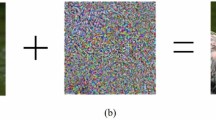Abstract
With the increase of malware, traditional malicious detection methods are not suitable to high-intensity detection work. In response to this question, many malware detection methods based on Machine Learning (ML-based) are proposed to address this problem. However, the ML-based detection method is vulnerable to the attack from adversarial samples. To overcome the limitation, we present our model. We protect the classification model from adversarial example attack by quantifying the similarity between the extracted image features and the expected features of the prediction class. Experimental results demonstrate that our model can detect the misclassification caused by adversarial samples with a higher accuracy than that of the Resnet-50.
Access this chapter
Tax calculation will be finalised at checkout
Purchases are for personal use only
Similar content being viewed by others
References
Bayer, U., Moser, A., Kruegel, C., Kirda, E.: Dynamic analysis of malicious code. J. Comput. Virol. 2(1), 67–77 (2006)
Gandotra, E., Bansal, D., Sofat, S.: Malware analysis and classifification: a survey. J. Inf. Secur. 5(2), 56–64 (2014)
IGoodfellow, I., Shlens, J., Szegedy, C.: Explaining and harnessing adversarial samples. arXiv preprint arXiv:1412.6572 (2015)
Rhode, M., Burnap, P., Jones, K.: Early stage malware prediction using recurrent neural networks. Comput. Secur. 77(8), 578–594 (2018)
HaddadPajouh, H., Dehghantanha, A., Khayami, R., Choo, K.K.R.: A deep recurrent neural network based approach for Internet of things malware threat hunting. Future Genera. Comput. Syst. 5(1), 88–96 (2018). https://doi.org/10.1016/j.future.2018.03.007
Wang, W., Zhao, M., Wang, J.: Effective android malware detection with a hybrid model based on deep autoencoder and convolutional neural network. J. Ambient Intell. Humanized Comput. 10(8), 3035–3043 (2018). https://doi.org/10.1007/s12652-018-0803-6
Vasan, D., Alazab, M., Wassan, S., Naeem, H., Safaei, B., Zheng, Q.: IMCFN: image-based malware classification using fine-tuned convolutional neural network architecture. Comput. Netw. 171(4), 107138 (2020). https://doi.org/10.1016/j.comnet.2020.107138
Nataraj, L., Karthikeyan, S., Jacob, G., Manjunath, B.S.: Malware images: visualization and automatic classifification. In: Proceedings of the 8th International Symposium on Visualization for Cyber Security, New York, NY, USA, pp. 1–7. ACM (2011)
Nataraj, L., Yegneswaran, V., Porras, P., Zhang, J.: A comparative assessment of malware classifification using binary texture analysis and dynamic analysis. In: Proceedings of the 4th ACM Workshop on Security and Artificial Intelligence, New York, NY, USA, pp. 21–30. ACM (2011)
Kalash, M., Rochan, M., Mohammed, N., Bruce, N.D.B., Wang, Y., Iqbal, F.: Malware classification with deep convolutional neural networks. In: 2018 9th IFIP International Conference on New Technologies, Mobility and Security (NTMS), pp. 1–5 IEEE (2018)
Zhang, C., Yang, X., Tang, Y., Zhang, W.: Learning to generate radar image sequences using two-stage generative adversarial networks. IEEE Geoence Remote Sens. Lett. 17(3), 401–405 (2020)
Huang, R., Xu, B., Schuurmans, D., Szepesvári, C.: Learning with a strong adversary. arXiv preprint arXiv:1511.03034 (2015)
Meng, D., Chen, H.: MagNet: a two-pronged defense against adversarial samples. [Online]. Available: https://arxiv.org/abs/1705.09064. (2017)
Parmuval, P., Hasan, M., Patel, S.: Malware family detection approach using image processing techniques: Visualization technique. Int. J. Comput. Appl. Technol. Res. 7(20), 129–132 (2018). https://doi.org/10.7753/IJCATR0703.1004
Liu, X., Zhang, J., Lin, Y., Li, H.: ATMPA: attacking machine learningbased malware visualization detection methods via adversarial examples. In: Proceedings of the International Symposium on Quality of Service (IWQoS 2019), Phoenix, AZ, USA, pp. 1–38. IEEE (2019)
Wang, L., Liu, J., Chen, X.: Microsoft malware classification challenge. [Online]. Available: https://arxiv.org/abs/1802.10135v1 (2018)
Acknowledgments
This work was supported by the National Natural Science Foundation of China under Grants No. 61572170 and 61672206, Program for Hundreds of Outstanding Innovative Talents in Higher Education Institutions of Hebei Province (III) under Grant No. SLRC2017042, and Natural Science Foundation of Hebei Province of China under Grant No. F2019205163, and department of Human Resoueces and Social Security of Hebei Province under Grant No. 201901028.
Author information
Authors and Affiliations
Corresponding author
Editor information
Editors and Affiliations
Rights and permissions
Copyright information
© 2020 Springer Nature Switzerland AG
About this paper
Cite this paper
Wang, F., Lu, Y., Li, Q., Wang, C. (2020). A Feature-Based Detection System of Adversarial Sample Attack. In: Chen, X., Yan, H., Yan, Q., Zhang, X. (eds) Machine Learning for Cyber Security. ML4CS 2020. Lecture Notes in Computer Science(), vol 12487. Springer, Cham. https://doi.org/10.1007/978-3-030-62460-6_44
Download citation
DOI: https://doi.org/10.1007/978-3-030-62460-6_44
Published:
Publisher Name: Springer, Cham
Print ISBN: 978-3-030-62459-0
Online ISBN: 978-3-030-62460-6
eBook Packages: Computer ScienceComputer Science (R0)




